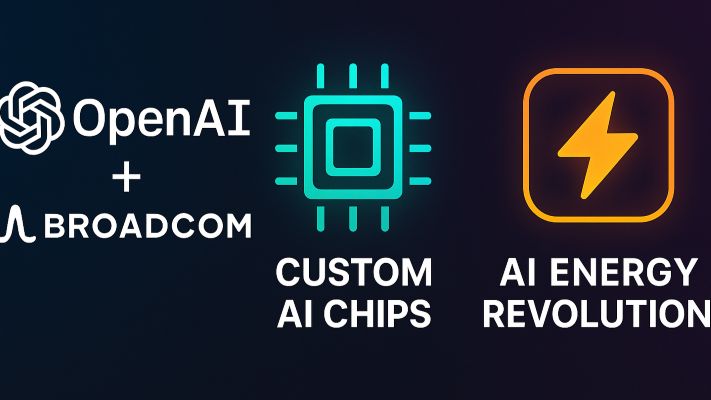AI Navigation
- articleAI Trends
- lightbulb_2AI Tips
- assistant_navigationAI Navigation
- heatHot Articles
- emergency_heat_2Hot Tips
- format_list_numberedPrompt Formatter
- psychologyTest Center(RPI)
October 14 2025 · 24-Hour AI Briefing: OpenAI Designs Its Own Chips, Samsung Surges on AI Boom, and ABB & NVIDIA Redefine Data-Center Power
Artificial intelligence is no longer just a race of algorithms — it’s a war for hardware sovereignty and energy efficiency.
This week, OpenAI’s move into self-designed AI chips, Samsung’s record-breaking profit rebound, and ABB’s partnership with NVIDIA mark a fundamental shift in the global AI supply chain — from silicon to power grid.

1. OpenAI Partners with Broadcom to Build Its Own AI Chips
OpenAI has announced a major partnership with Broadcom to develop and produce its first in-house AI processors.
The multi-round project will be financed directly by OpenAI and executed by Broadcom starting in late 2026. The deployment is planned to reach a massive 10 gigawatts (GW) of computing capacity — equivalent to the electricity used by over 8 million U.S. households.
Following the announcement, Broadcom’s stock jumped about 10%.
Commentary:
This marks OpenAI’s first major step into chip sovereignty. After years of dependence on NVIDIA’s GPUs, OpenAI is now taking control of its own compute pipeline. By co-developing custom hardware, OpenAI can fine-tune efficiency and performance to its own model requirements — a move that could reduce training costs and improve speed at scale.
A 10 GW infrastructure could power hundreds of GPT-5-class models, pushing AI energy consumption into “power-plant-scale” territory.
The stock reaction shows investors recognize the strategic impact — and Broadcom may become a new pillar of AI infrastructure as NVIDIA’s dominance faces fresh competition.
2. Samsung Reports $8.5 Billion in Quarterly Profit — AI Memory Drives the Comeback
Samsung Electronics posted an operating profit of $8.5 billion for Q3 2025 — its highest quarterly profit since 2022 — up 9% year over year. Fueled by AI demand, Samsung’s high-bandwidth memory (HBM) business is booming. The company has secured orders from AMD, and its HBM3E chips are now awaiting final qualification from NVIDIA.
Commentary:
Samsung, the world’s largest memory manufacturer, has emerged from the semiconductor downcycle and entered a new AI-driven “supercycle.”
If its 12-stack HBM3E design is approved for NVIDIA’s GB300 GPU, it could reshape the competitive landscape against SK Hynix and Micron.
Yet uncertainty remains — winning NVIDIA’s final certification is critical. Still, Samsung’s trajectory underscores how AI is redrawing the global memory market.
3. ABB & NVIDIA Team Up to Build Next-Generation AI Power Infrastructure
Global electrical engineering leader ABB has joined forces with NVIDIA to develop a new 800 V DC power architecture for AI data centers. The system will support 1-megawatt-class server racks and aims to deliver power more efficiently and with less energy loss.
Commentary:
NVIDIA’s planned shift to 800 V direct current represents a radical upgrade from today’s 48 V or 400 V standards. The higher voltage reduces transmission loss and heat, allowing for more sustainable data centers.
ABB’s expertise in high-voltage DC and industrial power systems makes it a natural partner.
If widely adopted, this architecture will force upgrades across the entire AI supply chain — from servers and power modules to cooling systems and facility design standards — triggering what some are already calling an “AI energy revolution.”
Final Thought
From OpenAI’s chip independence to NVIDIA’s power grid ambitions, AI is no longer just a battle of algorithms but a struggle over compute, energy, and infrastructure control. The future winners won’t just train the most powerful models — they’ll own the machines (and the electricity) behind them.
For more AI news, business insights, and technology trends, visit:
👉 https://iaiseek.com/en
Recent coverage:
October 10 2025 · 24-Hour AI Briefing: OpenAI Challenges Tech Giants, Apple Eyes Home Security, Xiaomi Tops China’s Smartphone Sales